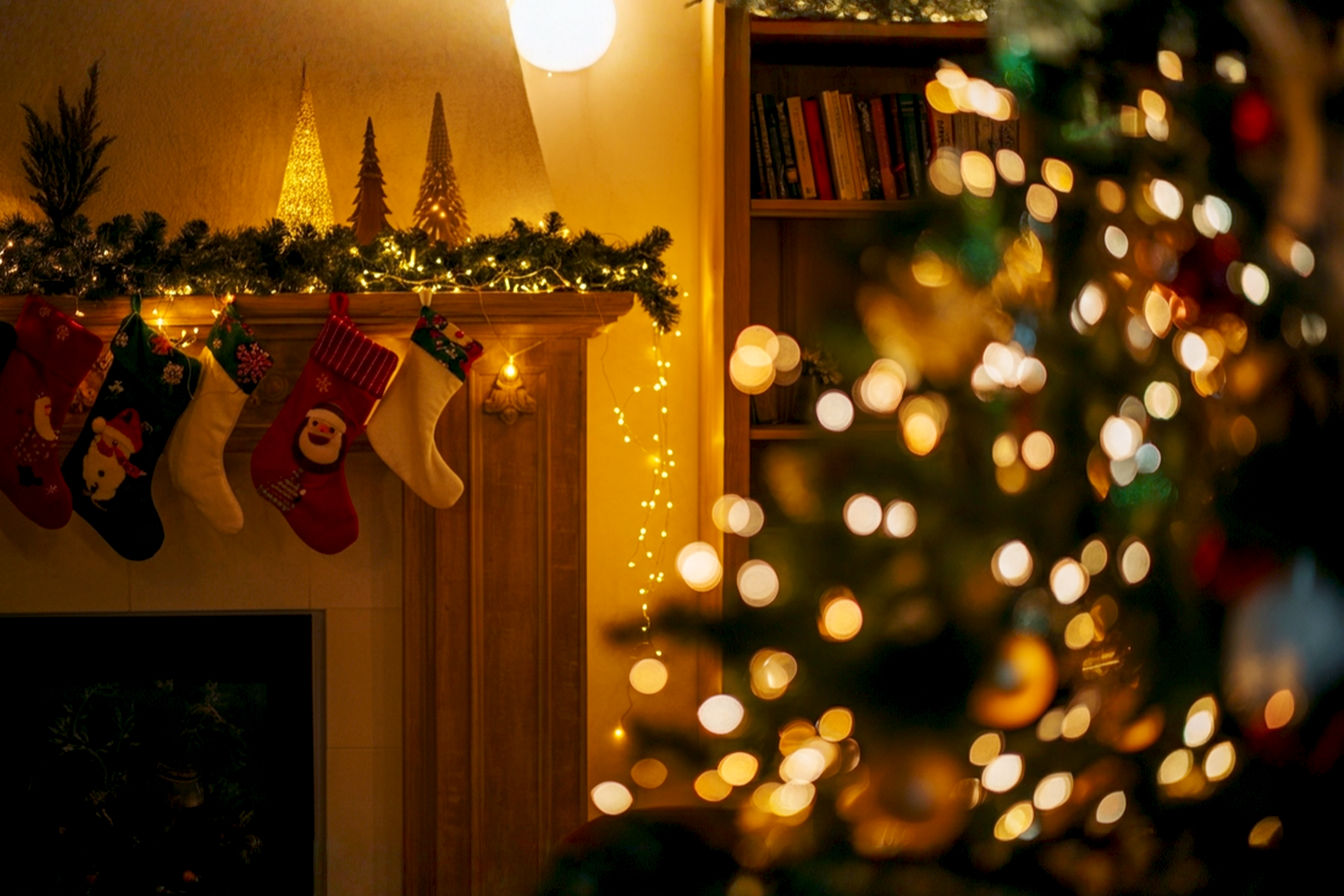This post may contain affiliate links. If you make a purchase through these links, we may earn a commission at no additional cost to you.
The holiday season is a magical time. Many people love to decorate their homes with festive lights and cheerful displays. While classic string lights and wreaths are always popular, nothing quite captures the spirit of Christmas like a giant Santa Claus inflatable. These impressive decorations instantly transform your yard into a festive wonderland. They bring smiles to faces of all ages.
Imagine a towering Santa, perhaps 10 or 12 feet tall, greeting everyone who passes by. It’s an immediate focal point. It also creates a sense of wonder and holiday cheer. These inflatables are incredibly popular for good reason. They are easy to set up, make a huge visual impact, and pack away compactly for storage. This guide will walk you through everything you need to know. We’ll help you choose, install, and maintain the perfect giant Santa inflatable for your outdoor display.
Understanding the Appeal: Why Go Big with Santa?
Choosing a giant inflatable Santa for your outdoor decorations offers many benefits. It’s more than just a decoration; it’s a statement.
First, a large inflatable creates an unforgettable festive focal point. Smaller decorations can get lost in a big yard. A giant Santa, however, stands out. It draws the eye and becomes the centerpiece of your holiday display. This makes your home a landmark during the holiday season. Neighbors and passersby will surely notice and appreciate your festive spirit.
Second, these inflatables are fantastic at drawing attention and delight. Children especially love seeing these larger-than-life characters. They often point, wave, and even pose for photos with the cheerful Santa. This interaction adds a unique, joyful element to your holiday decorating efforts. It helps spread genuine happiness throughout your community.
Finally, consider the ease of setup and takedown compared to traditional displays. Traditional holiday decorating often involves hours of stringing lights, hanging ornaments, and arranging heavy props. A giant inflatable Santa, on the other hand, typically self-inflates in minutes. You just plug it in. When the season ends, it deflates quickly and folds into a surprisingly small package. This saves you a lot of time and effort. It also makes holiday decorating much less of a chore.
Key Considerations Before You Buy: The Essentials
Before you rush out to buy the biggest Santa you can find, it’s wise to consider a few key factors. These will ensure you pick an inflatable that fits your needs and lasts for many holiday seasons.
Size Matters: Choosing the Right Scale for Your Space
The size of your giant Santa inflatable is one of the most important decisions. It directly affects visibility, impact, and how well it fits into your outdoor space.
You should start by measuring your yard or roof. Think about where you want to place Santa. Measure the height, width, and depth of that area. Remember to account for any nearby trees, power lines, or architectural features. You don’t want Santa to be squashed or obstructed.
Giant Santa inflatables come in a wide range of common sizes. You’ll often see options like 6 feet, 8 feet, 10 feet, 12 feet, and even 15 feet or taller. A 6-foot Santa might be perfect for a smaller front yard or a porch. An 8-foot or 10-foot Santa is a popular choice for average-sized yards. It offers a good balance of visibility and manageability. If you have a very large property or want to make a truly grand statement, a 12-foot or 15-foot+ Santa will certainly do the trick.
The impact on visibility and stability is crucial. A taller Santa will be seen from further away. This is great if your home is set back from the road. However, larger inflatables require more robust anchoring. They are also more susceptible to strong winds. Always balance the desire for a huge display with the practicalities of your specific outdoor environment.
Material Durability: Withstanding the Elements
Your giant Santa inflatable will face various outdoor conditions. This includes rain, snow, wind, and sunlight. That’s why the material it’s made from is incredibly important for its longevity.
Most outdoor inflatables are made from types of polyester fabric or Oxford fabric. Polyester is a synthetic fiber known for its strength and resistance to shrinking and stretching. Oxford fabric is a type of basket-weave fabric, often made from polyester or nylon. It’s known for its durability and water resistance. Oxford fabric, especially with higher denier counts, generally offers superior strength and tear resistance compared to basic polyester.
The denier count is a key technical specification. It tells you about the thickness and density of the fabric’s fibers. Denier (D) is a unit of measurement for the linear mass density of fibers. A higher denier count means a thicker, stronger, and more durable fabric. For example, a fabric with a 600D denier count is much tougher and more resistant to tears and abrasions than a fabric with a 190T (thread count) or 210D rating. While 190T or 210D might be fine for smaller, less exposed inflatables, a giant Santa that will stand up to winter weather should ideally be made from 420D, 600D, or even 800D Oxford fabric. This higher denier count provides better resilience against punctures and general wear and tear.
UV resistance and fade prevention are also critical. Prolonged exposure to sunlight can cause the colors of your inflatable to fade over time. Look for materials that are specifically treated for UV resistance. This helps maintain Santa’s vibrant red suit and rosy cheeks for many seasons. Some manufacturers apply a special coating. Others weave in UV-resistant fibers.
Finally, ensure the material offers good waterproofing and weather resistance. While most inflatables are designed for outdoor use, some are better equipped than others. The fabric should be water-resistant, meaning it can repel water to a certain extent. Some high-quality inflatables may even feature a waterproof coating or sealed seams. This prevents water from seeping in and damaging the internal components like the fan or lights. A truly weather-resistant inflatable can withstand light rain and snow without issues. However, it’s always best to deflate during heavy downpours or blizzards.
Inflation Mechanism: The Heart of Your Santa
The fan inside your inflatable is what brings Santa to life. Understanding its features is key to a hassle-free display.
Most giant Santa inflatables come with a built-in fan. These fans are typically small, powerful blowers designed to inflate the fabric structure quickly and keep it rigid. The power of the fan is often measured in cubic feet per minute (CFM) or simply by its wattage. A more powerful fan will inflate Santa faster and maintain his shape better, especially in light breezes. For larger inflatables (10 feet and up), you’ll need a fan with more robust airflow to ensure full inflation.
Noise levels are an important consideration, especially if the inflatable will be close to your home or a neighbor’s. Fans can produce a noticeable hum. Manufacturers sometimes provide a dB rating (decibel rating) for their fans. A lower dB rating means a quieter operation. While no fan is completely silent, some are designed to be less intrusive than others. Look for models that mention “low noise” or “quiet operation” in their descriptions.
The inflation time is how long it takes for Santa to fully stand up once plugged in. Most self-inflating units will be fully inflated within a few minutes, often between 1 to 5 minutes depending on the size and fan power. This quick setup is a major convenience.
Finally, consider the power consumption (watts) of the fan and lights. While inflatables are generally energy-efficient compared to traditional string lights, a very large Santa with a powerful fan and numerous lights will naturally use more electricity. Check the wattage listed in the product specifications. This helps you estimate your energy costs during the holiday season. Most standard inflatables consume between 50 to 150 watts, but very large ones can go higher.
Lighting: Illuminating Your Festive Display
What’s a giant Santa without a festive glow? Internal lighting makes your inflatable visible and enchanting after dark.
Most giant Santa inflatables feature internal LED lights. These lights are strategically placed inside the inflatable to illuminate the entire structure from within. This creates a soft, inviting glow that makes Santa stand out even in the darkest night. LEDs are chosen for their energy efficiency, long lifespan, and durability.
There are different types of LEDs used. Some inflatables might use small, numerous “mini LEDs” that provide a subtle sparkle. Others might incorporate larger, brighter C7 or C9 LED bulbs. These provide a more pronounced and vibrant illumination. The brightness of the lights is measured in lumens. A higher lumen count means a brighter Santa. The color temperature of the lights can also vary, from warm white (more traditional, yellowish glow) to cool white (brighter, bluish glow). Choose a color temperature that matches your overall holiday lighting scheme.
Energy efficiency is a significant advantage of LED lighting. LEDs consume far less electricity than older incandescent bulbs. This means your illuminated Santa won’t drastically increase your power bill. They also generate very little heat, which is safer for the fabric of the inflatable.
The placement for even illumination is important. Good quality inflatables will have lights distributed throughout the structure. This ensures Santa is evenly lit and doesn’t have dark spots or shadows. Check product images or reviews to see how well the inflatable is lit at night. Some cheaper models might only have a few lights, leading to uneven illumination.
Anchoring and Stability: Keeping Santa Grounded
A giant Santa needs to stay put, especially when the wind picks up. Proper anchoring is essential for safety and to prevent your festive display from becoming a runaway balloon.
Most inflatables come with stakes to secure them to the ground. These can be made of plastic or metal. Metal stakes are generally superior. They are more durable and provide a stronger hold in various soil types. Plastic stakes can be brittle in cold weather and may not offer enough grip in soft ground. Look for inflatables that include sturdy, rust-resistant metal stakes.
Tie-down ropes are equally important. These ropes attach to loops or D-rings on the inflatable’s body and then to the ground stakes. Their importance cannot be overstated. They provide lateral stability, preventing Santa from swaying excessively or toppling over in windy conditions. Ensure the ropes are strong and the attachment points on the inflatable are reinforced. You’ll need to tension these ropes correctly to provide maximum stability.
For added weight and stability, especially for very large inflatables or in windy areas, consider using sandbags or water bags. These can be placed inside the base of the inflatable. Some inflatables even have internal pockets designed to hold these weights. This extra ballast significantly lowers the center of gravity. It makes Santa much more resistant to gusts of wind.
Finally, look for wind resistance design features. Some high-quality inflatables are designed with internal baffling or multiple inflation chambers. These features help maintain the shape and rigidity of the inflatable even when facing moderate winds. While no inflatable is truly windproof in a gale, these design elements improve its performance in less severe conditions. Always deflate your Santa during strong winds (typically over 20-25 mph).
Advanced Features and Smart Choices
Beyond the basics, some giant Santa inflatables offer extra features that enhance their appeal and convenience.
Self-Inflating vs. Manual Inflation
The vast majority of modern giant inflatables are self-inflating. This means they have a built-in fan that automatically inflates the structure when plugged into an electrical outlet. This offers immense convenience. You simply unroll Santa, plug him in, and watch him come to life in minutes. This hands-free operation is a major time-saver during busy holiday preparations.
While rare for giant models, some smaller inflatables or those designed for very specific uses might require manual inflation. This would involve using an external air pump, similar to inflating an air mattress. This is generally less convenient for large outdoor displays. However, manual inflation can be useful for minor top-ups or for inflating a small section if the built-in fan is temporarily blocked or damaged. For giant Santas, always prioritize a self-inflating model.
Animated Features
Some premium giant Santa inflatables go beyond static displays by incorporating animated features. These can include waving arms, rotating heads, or even Santa appearing to climb a ladder. These movements add an extra layer of dynamism and visual interest to your display. They make Santa feel even more alive and engaging.
However, animated features do have implications. They typically impact power consumption and complexity. Moving parts require additional motors and mechanisms, which can draw more electricity than a static inflatable. The added complexity also means there are more components that could potentially malfunction. While charming, animated features might mean a slightly higher initial cost and potentially more maintenance over time.
Sound and Music Integration
To truly immerse visitors in the holiday spirit, some advanced inflatables offer sound and music integration. This can range from simple built-in speakers that play a loop of classic Christmas carols to more sophisticated systems with Bluetooth connectivity. Bluetooth allows you to connect your smartphone or other devices and play your own custom holiday playlists through Santa’s internal speakers.
This feature adds an auditory dimension to your display. It enhances the overall festive atmosphere. Consider the quality of the speakers and the volume control options. Also, be mindful of your neighbors when playing music outdoors, especially late at night.
Remote Control and Timer Functions
For ultimate convenience, look for giant Santa inflatables that include remote control and timer functions. A remote control allows you to turn Santa on or off with the press of a button, without having to venture outside to unplug him. This is especially handy on cold or rainy nights.
Timer functions are even more useful. These allow you to schedule display times automatically. For example, you can set Santa to inflate at dusk and deflate at midnight. This saves energy and ensures your display is only active when people are around to enjoy it. Timers are often built into the power adapter or controlled via the remote. This feature adds a layer of “set it and forget it” convenience to your holiday decorating.
Repair Kits and Spare Parts
Even the most durable inflatable can suffer minor damage over time. That’s why the inclusion of repair kits and spare parts is a valuable addition. A good quality inflatable should come with a small patch kit. This typically includes adhesive patches made from the same material as the inflatable. These are used for quickly repairing small tears or punctures. Knowing how to use these patches can save you from having to replace your entire Santa for a minor flaw.
It’s also beneficial if the manufacturer offers availability of replacement fans or lights. While less common, a fan motor can burn out or an LED string can fail. Having the option to purchase replacement parts directly from the manufacturer or a third-party supplier ensures your investment lasts longer. Check the product description or manufacturer’s website for information on spare parts availability.
Installation and Setup: Getting Santa Ready for Show Time
Once you’ve chosen your perfect giant Santa, it’s time to bring him to life. Proper installation is key for both visual appeal and safety.
Site Selection
Before unpacking Santa, take a moment to choose the best spot. First, look for a flat, clear surface. An uneven ground can make Santa lean or appear distorted. Clear the area of any sharp objects like rocks, sticks, or exposed roots. These could potentially puncture the inflatable’s fabric.
Next, consider proximity to a power source. You’ll need an outdoor-rated electrical outlet nearby. Plan your extension cord route to avoid tripping hazards. Finally, think about visibility from the road. You want Santa to be seen and enjoyed by as many people as possible. Position him where he’s clearly visible without being obstructed by trees, bushes, or other decorations.
Unpacking and Unfolding
When you receive your inflatable, unpacking and unfolding it carefully is important. Avoid using sharp objects like knives or scissors to open the box, as you could accidentally cut the fabric. Gently remove Santa from his packaging.
Once out, lay it out correctly on the chosen flat surface. Spread the fabric out completely, ensuring there are no twists or kinks. Make sure the fan opening is clear and not obstructed by the fabric. This careful unfolding helps ensure smooth and rapid inflation. It also prevents unnecessary stress on the seams.
Securing Your Inflatable
This is perhaps the most critical step for outdoor inflatables. Securing your inflatable properly prevents it from blowing away or falling over.
Start with proper stake placement. Most inflatables have loops or tabs at their base. Insert the provided stakes through these loops and firmly into the ground. Angle the stakes slightly away from the inflatable for better grip. For larger inflatables, there will also be tie-down points higher up on Santa’s body.
Next, focus on tensioning tie-down ropes. Attach the provided ropes to these upper tie-down points. Then, extend the ropes outwards at an angle (ideally 45 degrees) and secure them to additional ground stakes. Adjust the tension of these ropes until Santa stands upright and firm. The ropes should be taut but not so tight that they pull the fabric excessively. This creates a stable, multi-point anchoring system.
Finally, consider using additional weights. As mentioned before, sandbags or water bags placed inside the base of the inflatable can significantly enhance stability, especially in areas prone to wind. Even if your inflatable comes with stakes and ropes, extra weight is always a good idea for giant models.
Powering Up
With Santa secured, it’s time to bring him to life with electricity. Always use outdoor-rated extension cords. These cords are designed to withstand moisture and temperature changes. Standard indoor cords are not safe for outdoor use and can pose a fire or shock hazard.
Plug your extension cord into a GFCI outlet (Ground Fault Circuit Interrupter). GFCI outlets are designed to detect ground faults and quickly shut off power, preventing electrical shocks. Many outdoor outlets are already GFCI-protected. If yours isn’t, consider using a portable GFCI adapter.
Finally, protect connections from moisture. Use weatherproof covers for all outdoor electrical connections. You can also use specialized “cord protectors” or waterproof electrical boxes to keep plugs and outlets dry. Water and electricity are a dangerous combination, so take every precaution to keep connections sealed and dry.
Maintenance and Care: Keeping Santa Jolly Year After Year
Proper care will extend the life of your giant Santa inflatable, ensuring he brings cheer for many holiday seasons.
Cleaning Your Inflatable
Over a season, your inflatable can get dirty from dust, leaves, and general outdoor exposure. Cleaning your inflatable regularly will keep him looking his best.
Always use gentle cleaning methods. First, make sure Santa is deflated and unplugged. Use a soft cloth or sponge with a solution of mild soap and water. Dish soap or a gentle laundry detergent works well. Gently wipe down the fabric surfaces. Avoid scrubbing harshly, as this can damage the material or graphics. For stubborn spots, a soft brush can be used, but always test on an inconspicuous area first.
It’s crucial to avoid harsh chemicals. Bleach, abrasive cleaners, or strong solvents can damage the fabric, fade colors, or break down the material’s protective coatings. Stick to mild soap and water.
After cleaning, dry thoroughly. This is perhaps the most important step before storage. Lay the inflatable out in a clean, dry area, preferably in sunlight, until it is completely dry. Any moisture left on the fabric can lead to mildew, mold growth, or material degradation during storage. Ensure every fold and crease is dry before packing it away.
Repairing Minor Damage
Accidents happen. A small tear or a fan issue doesn’t mean your Santa is ruined. Repairing minor damage can save your inflatable.
For patching tears, use the included adhesive patches from your repair kit. If you don’t have one, you can often buy universal inflatable repair kits. Clean the area around the tear. Cut a patch slightly larger than the tear, with rounded corners to prevent peeling. Apply the patch firmly, ensuring good adhesion. Some kits may also include fabric glue for more secure or larger repairs. For very small pinholes, a dab of fabric glue might be enough. Always follow the instructions on your repair kit.
If Santa isn’t inflating properly, it might be a fan troubleshooting issue. First, check for any blockages in the fan’s intake or exhaust. Leaves, debris, or even tangled fabric can prevent proper airflow. Clear any obstructions. If the fan still isn’t working, check the power connection. If the fan motor hums but doesn’t spin, it might have a minor issue that can sometimes be fixed by gently nudging the fan blades (with power off, of course). If the motor is dead, you might need a replacement fan unit.
Deflation and Storage
When the holidays are over, proper deflation and storage are vital for preserving your inflatable.
First, ensure complete deflation. Unplug Santa and allow all the air to escape naturally. You can gently press down on the inflatable to help push out any remaining air. The more air you remove, the more compactly it will store.
Next, fold neatly to prevent creases and damage. Once deflated, carefully fold or roll the inflatable. Try to avoid sharp creases that can weaken the fabric over time. Folding along existing seams is often a good strategy. If your inflatable came with a storage bag, use it. If not, a large plastic storage bin or a heavy-duty duffel bag works well.
Finally, store in a cool, dry place, away from pests. A garage, attic, or basement is usually suitable, as long as it’s dry and free from extreme temperature fluctuations. Keep the inflatable off the floor if possible, to protect it from moisture or rodents. Pests like mice can chew through fabric, so ensure your storage area is secure.
Safety First: Important Considerations for Outdoor Displays
Safety should always be your top priority when setting up any outdoor electrical display.
Electrical Safety
When dealing with outdoor electrical items, electrical safety is paramount. Always ensure all connections are waterproof. Use weatherproof covers for plugs and outlets. Avoid exposing any electrical connections directly to rain or snow.
Be mindful of avoiding overloaded circuits. Don’t plug too many high-wattage decorations into a single outlet or circuit. This can trip breakers or, worse, create a fire hazard. If you’re unsure, consult an electrician.
Finally, perform regular inspection of cords and plugs. Before and during the season, check all extension cords and the inflatable’s power cord for any signs of damage, fraying, or exposed wires. Replace any damaged cords immediately.
Wind and Storm Safety
Giant inflatables are essentially large sails. Therefore, wind and storm safety are crucial. Always deflate during high winds. A general rule of thumb is to deflate if winds are expected to exceed 20-25 miles per hour (about 32-40 kilometers per hour). Strong winds can rip the fabric, damage the fan, or even cause the inflatable to become a dangerous projectile.
Monitoring weather forecasts is a good habit during the holiday season. If a major storm, heavy rain, or significant snowfall is predicted, it’s best to deflate Santa beforehand. While many inflatables are weather-resistant, extreme conditions can overwhelm them.
Placement Safety
The location of your inflatable also impacts safety. Ensure you are avoiding tripping hazards. Run extension cords along walls or paths where they won’t be stepped on. If a cord must cross a walkway, use a cord protector or secure it firmly to the ground with tape designed for outdoor use.
Also, keep away from sharp objects or heat sources. Don’t place Santa near thorny bushes, sharp fences, or anything that could puncture the fabric. Similarly, keep him away from outdoor heaters, fire pits, or open flames, as the fabric is typically flammable.
Child and Pet Safety
Finally, consider child and pet safety. While inflatables are generally safe, supervision is always recommended. Children might be tempted to play with the inflatable, which could lead to damage or entanglement.
Ensure securing stakes properly. Stakes should be fully driven into the ground so that no sharp points are exposed. This prevents accidental injuries to children or pets who might run into them. Regularly check that all tie-downs and stakes are secure throughout the season.
Where to Buy: Finding Your Perfect Giant Santa
With all this knowledge, you’re ready to find your giant Santa. You have several good options for purchasing.
Online retailers offer the widest selection. Websites like Amazon, Wayfair, and Home Depot online are popular choices. They carry a vast array of sizes, designs, and brands. Shopping online allows you to easily compare features, read customer reviews, and often find competitive pricing. Be sure to check shipping costs and return policies.
Brick-and-mortar stores are also an option, especially during the holiday season. Large general merchandise stores, home improvement stores, and department stores often dedicate significant sections to holiday decorations. This allows you to see the inflatable in person (though usually not inflated) and get a feel for the material quality. However, their selection might be more limited than online.
For truly unique or high-quality options, consider specialty holiday decoration stores. These shops often carry premium brands and more elaborate designs. They might also offer expert advice.
No matter where you shop, always prioritize comparing prices and reviews. Don’t just pick the first Santa you see. Read what other buyers have to say about durability, fan noise, lighting, and ease of setup. This feedback can be invaluable in making an informed decision.
Budgeting for Your Giant Santa
Giant Santa inflatables come in a range of prices. Your budget will depend on size, features, and brand.
Price ranges vary significantly. A smaller, basic 6-foot Santa might cost anywhere from $50 to $100. A medium-sized (8-10 foot) Santa with good features could be $100 to $250. Large, animated, or premium 12-foot+ Santas can easily range from $250 to $500 or more. The more advanced features (animation, sound, remote control) and higher denier fabric will generally increase the price.
When budgeting, think about considering long-term value and durability. A cheaper inflatable might save you money upfront, but if it only lasts one season, it’s not a good investment. Spending a bit more on a higher-quality model made from durable materials with a robust fan will likely save you money in the long run by lasting for many years.
Finally, don’t forget accessories. While many inflatables come with basic stakes and ropes, you might want to budget for extra, stronger metal stakes, additional sandbags, or a weatherproof extension cord. These small additions can significantly improve the performance and safety of your display.
Troubleshooting Common Issues
Even with the best preparation, you might encounter a few hiccups. Here are solutions to common problems:
- Santa won’t inflate fully:
- Check power: Ensure it’s plugged in and the outlet is working.
- Fan obstruction: Look for leaves, debris, or tangled fabric blocking the fan’s intake or exhaust.
- Zipper/Velcro: Make sure all zippers and Velcro closures on the inflatable are completely sealed. Many inflatables have a zipper for deflation or access to the fan; if it’s open, air will escape.
- Puncture/Tear: Inspect the fabric for any holes or tears. Use your repair kit if you find one.
- Fan motor: If the fan hums but doesn’t spin, the motor might be stuck or faulty.
- Lights aren’t working:
- Check connections: Ensure all internal light connections are secure.
- Bulb failure: Some inflatables use individual bulbs that can burn out. Check if replacements are available. LED strings are generally more reliable but can still fail.
- Power to lights: Ensure the power source for the lights (sometimes separate from the fan) is active.
- Santa keeps falling over:
- Insufficient anchoring: You likely need more or stronger stakes.
- Loose tie-downs: Tighten the ropes, ensuring they are taut and angled correctly.
- No internal weight: Add sandbags or water bags to the base.
- High winds: Deflate Santa during strong gusts.
- Fan is too noisy:
- Obstruction: Check for anything rattling inside the fan housing.
- Loose parts: Ensure the fan unit is securely mounted.
- Normal operation: Some fans are just louder than others. If it’s excessively loud and new, it might be a defect.
Conclusion: A Festive Investment for Years to Come
Bringing a giant Santa Claus inflatable into your outdoor holiday display is more than just decorating; it’s about creating joy and lasting memories. This guide has covered the essential steps. We’ve talked about choosing the right size and material. We’ve also discussed understanding the fan and lighting. And we’ve covered how to properly anchor, install, and maintain your inflatable.
Remember to prioritize durability with high-denier fabrics. Ensure stability with strong stakes and tie-downs. Don’t forget the importance of electrical safety. By making informed choices, you’re not just buying a decoration. You’re making a festive investment. This investment will bring cheer to your home and community for many holiday seasons to come. Get ready to spread some serious outdoor cheer!






